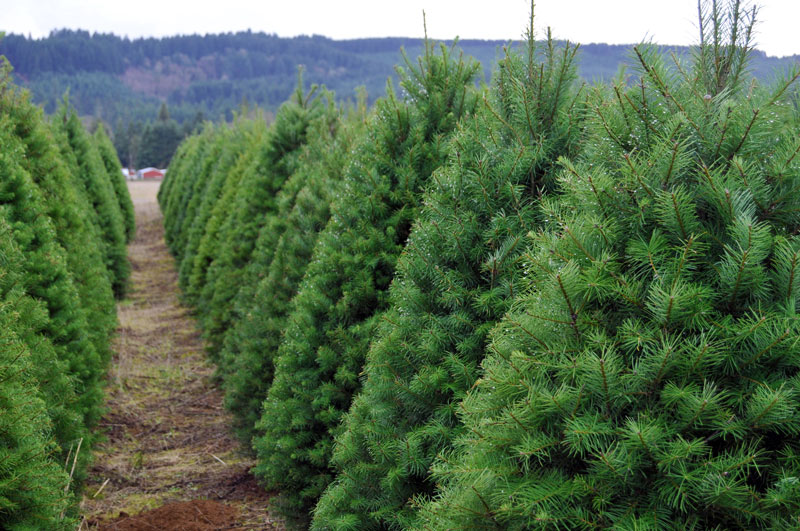
Bountiful boughs: Approximately 310 million Christmas trees are currently growing on U.S. Christmas tree farms, with Oregon, North Carolina and Michigan being the highest-producing states. Photo by Vlue/Shutterstock.com
Though the de-decking of the halls gets no festive jingle, the abundance of free plant material up for grabs each winter as millions of Christmas trees are ousted from their holiday homes is a noteworthy occasion in its own right. “Because Christmas trees are plants, they’re a valuable natural resource, and we want to get them back into the ecosystem,” says Rick Dungey, executive director of the National Christmas Tree Association. “And just a little effort can go a long way.”
In the United States, about 35 species of conifers are grown as Christmas trees, and 25 to 30 million fresh Christmas trees are sold every year. Whether you have just a tannenbaum or two from the clubhouse or a large supply courtesy of a community tree-cycling project, golf courses are uniquely positioned to return Christmas trees to nature in a variety of practical, beneficial ways — a full-circle life cycle worth celebrating.
For fish
Christmas trees are exceptional among much recycled plant matter, Dungey says, because of their size — the discarded material is a large, intact entity instead of, say, leaves or grass clippings. This trait lends the plants to his favorite repurposed application: sunk whole into lakes or ponds as a habitat for fish.
The underwater mass furnishes certain fish with a food source and a place to hide from predators and lay their eggs, and the tree then becomes a congregation post for predatory fish looking to dine. As the woody material of the tree breaks down, it also feeds this aquatic food chain, all fostering a robust ecosystem.
To establish a Christmas tree in a lake or pond, tie a cinder block to the stump to anchor it, and make sure the top of the tree is no more than 10 feet beneath the water so that light can still reach it, Dungey advises.
For the landscape
Christmas trees can be chipped whole — needles and all — to create mulch. The maintenance yard at Saddle Rock Golf Course in Aurora, Colo., has long been a drop-off destination on behalf of the city’s Christmas tree recycling program (a number of city-run tree recycling initiatives across the country enlist municipal courses as collection sites). Superintendent Michael Osley, CGCS, says collection commences the week of Christmas and lasts until about the end of January, with the city’s forestry department periodically coming by to chip the trees into mulch, which is then available to the public.
The main benefit of the program, Osley says, is that the golf course is able to help provide a sustainability service to Aurora residents, but he also takes advantage of a share of the free mulch, using it in various places around the course for the aesthetic quality it imparts, as well as on walking paths to prevent soil erosion.
Among mulches, wood chips — referring to the combination of leaves, bark and wood resulting from chipped trees — stand out for their ability to add nutrients and organic matter to the soil as they decompose, says Tom Smiley, Ph.D., an arboriculture researcher with Bartlett Tree Research Laboratories. In turn, that organic matter enhances soil’s water- and nutrient-holding capacity. “The soil will hold nutrients in the upper 6 inches, where tree roots and shrub roots can take advantage of those nutrients,” Smiley says. “Water will percolate better through the soil, and the soil will also hold on to more of that water, so wood mulch gives the best of both worlds.”
The organic matter is also a boon to beneficial soil fungi and insects, and wood chips are great for areas trafficked by foot because they allow soil to resist compaction, reducing its water repellency. Smiley notes that wood mulches made with pine needles will be more acidic than others.
For wildlife
A simple, straightforward use for Christmas trees is reimagined as a refuge for birds, small mammals, reptiles and amphibians. Tim Hiers, CGCS, director of agronomy at The Club at Mediterra in Naples, Fla., has been turning dead trees into “woodpiles” on his courses for years, and he says the strategy is as easy as it sounds. The heaps become havens for the likes of birds, rabbits, mice, lizards, and all manner of critters seeking shelter from the elements and predators.
Position your pile in an out-of-sight location, and in a place where you know wildlife exist and will be able make use of it. Start with your larger trees or limbs as a base, and then “pyramid up,” says Hiers, who typically builds his woodpiles about 5 feet by 5 feet, and 3 to 5 feet tall.
In Hiers’ view, practices such as Christmas tree recycling that give back to the ecosystem allow superintendents to become stewards of the entirety of the land under their management rather than just the golf course. “It makes the superintendent’s job more interesting,” Hiers says. “And you’re able to show people — not just tell people — that you care about the environment.”
Megan Hirt is GCM’s managing editor.